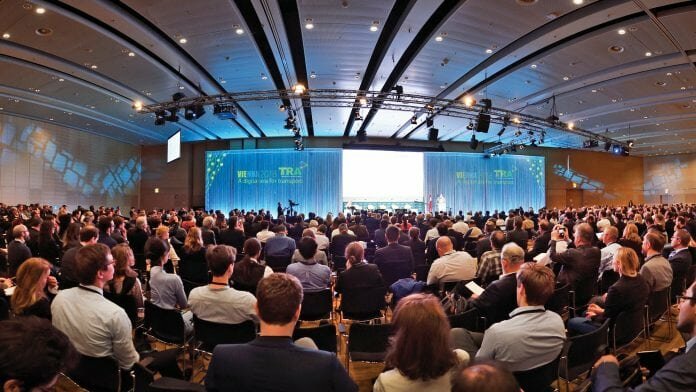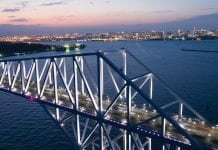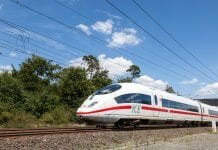
From 16-19 April 2018, experts and stakeholders of the transport and mobility sector met at the Transport Research Arena conference in Vienna, Austria.
“A Digital Era for Transport – solutions for society, economy and environment” was the motto of the Transport Research Arena (TRA) 2018 event in Vienna, Austria. From 16-19 April, researchers, companies, transport authorities and policy makers, as well as other relevant stakeholders met in Vienna to discuss innovations and the future of the transport and mobility sector. And with more than 3,600 participants from 65 different countries, TRA 2018 attracted a record number of spectators.
Designed as an open arena for discourse and exchange, TRA set different priorities during the four-day conference. With a focus on digital technologies and transformation, as well as decarbonising transport and respective skills and behaviours, attendees had the opportunity to consume and create more than 8,500 minutes of sessions. A lot of dialogue and specific space for future talents – like women in transport, best young and senior researcher talents, and start-ups – were provided. A total of four plenary sessions, 12 strategic sessions, 23 invited sessions and 52 scientific and technical sessions were at the heart of the conference – embedded in many other interactive possibilities.
Transport needs to become safer, cleaner and more innovative
Day one was opened by the European Commission and the Austrian Federal Ministry for Transport, Innovation and Technology with remarks on the future agenda of the transport and mobility sector in Europe. The consensual message of both was to carry forward the goals of a safer, more efficient and more environmental friendly industry by fostering European co-operation and innovation. Followed by an opening keynote of futurist Gerd Leonhard and an industrial round table set the tone for the conference.
With aviation being present for the first time at TRA, all modes of transport were covered. Not only by the scientific programme, but also by an exhibition arena of more than 7,000m². Many companies and organisations seized this opportunity to show latest innovations, products and research results. The formats used to interact with the visitors were diversified in many ways. The market place, for example, offered the opportunity for young researchers and professionals to present their ideas and concepts to stakeholders from industry, research and policy. Scientific posters and interactive events completed this format.
The importance of diversity
TRA 2018 also countered the issue of an imbalanced gender distribution in the transport sector and is proud to report a 27% share of women. Sessions with the theme “Inclusion, you said?” and a unique women’s reception were only a selection of the focal points on women at this year’s Transport Research Arena conference. These and other measures, such as the “Declaration for Equal Opportunities for Women & Men in Transport”, are intended to drive forward the positive development for a higher proportion of women in a scientific and technological field, such as transport, of which is still dominated by men.
From Austria to Finland
For four days, TRA 2018 turned Vienna into the European mobility centre and demonstrated the rapid pace of change and development in the mobility sector through a focus on digitalisation. This created a starting point for further discussions on current trends, which are to be held in two years’ time. The next Transport Research Arena will take place from 26-30 April 2020 at the Messukeskus Expo and Convention Centre in the Finnish capital Helsinki. The motto of the next edition of the TRA is “Enabling the transformation – transport and mobility (r)evolution for smart, green and integrated society”, and focuses on innovative ways of enabling Europe-wide transformation across the transport and mobility sector, the disruption of traffic and mobility research, development and innovation.
The Interactive Zone – an all new format with a focus on hands-on showcasing
Why showcasing matters, as a contrast to a rather theoretical conference programme, became perceptible in the Interactive Zone. The all new format gathered research institutions, projects, start-ups and companies for the opportunity to showcase the tangible outcomes of research. For exclusive insights into learnings and the purpose of the Interactive Zone, Martin Russ, managing director of AustriaTech, made some remarks below:
Mr. Russ, why do the hands-on presentations from the Interactive Zone make a difference?
Because we need to become better in communicating the benefits and possibilities of new technologies and innovation. Especially at a research conference, with its many sessions, it is important to break out of the formats and learn things in a playful way. So, as in transport itself, the conference is becoming more ‘experimental’, because we are not talking about finished products and always have to take into account that we could hit a dead end. With tangible exhibits or virtual reality showcases, ideas and concepts can sometimes be communicated much more easily. That’s why showcasing makes a difference.
What do you think was the unique selling point of the Interactive Zone?
In the transport and mobility sector, it is almost always about the connections and the context that an innovation or technology has with its environment. That was the exciting thing about the Interactive Zone. We not only presenting a single technology or a prototype, but topic-clusters of new approaches. For example, in the field of automated driving, yes, it’s about the vehicle and the vehicle’s abilities. But it is also about embedding, co-operation and networking of vehicles. And more than that, we have to seek new perspectives. Perhaps the innovative approach does not come from the road sector, but from aviation. To take advantage of such opportunities, we have simply put many different players into one boat in the Interactive Zone.
What personally inspired you about the Interactive Zone?
The exciting thing for me was that we were able to also inspire others to take an active part in it. We could have just said: OK, we do this alone. But the consideration of another form of knowledge transfer and the marketing of science and research results has been carried by many different projects. So, I will clearly take it with me as a learning tool in the future if we participate in a research programme or funded project, especially in planning such events. That doesn’t always have to be the same size, but you could sometimes bring different projects together under one topic and I believe that much more can be achieved in this way.
Transport Research Arena
https://www.traconference.eu/


















